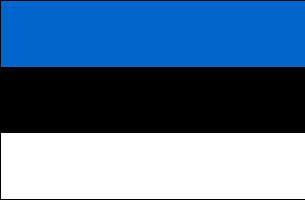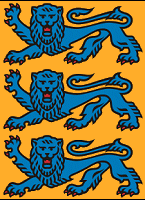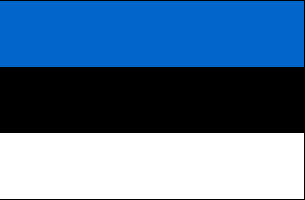  
ESTONIA
Capital: Tallinn
Area: 17,462 sq. miles
Population: 1,381,000 (2001 estimate)
Language(s): Estonian is the official language, but Latvian, Lithuanian, and Russian are also spoken.
Ethnic Groups: Estonian - 61.5%; Russian - 30.3%; Ukrainian - 3.2%; Belarusian - 1.8%; Finnish - 1.1%;
other - 2.1%.
Religion(s): The principal religions are Evangelical Lutheran, Russian Orthodox, and Estonian Orthodox.
Currency: Kroon
System of Government: Republic
The first permanent settlements in what is today Estonia, appeared about the same time as in Finland, that is around 100 A.D., when migrating tribes crossed over from the south side of the Gulf of Finland. They were part of the Finnic peoples which had originated in Central Eurasia and eventually evolved into such groups as the Finns, Estonians, Maris, Mordvinians and Lapps.
The Estonians over the centuries developed a westward orientation through trade, primarily with the Finns and the Swedes. Gradually, the Swedes established control over the Finns and the Estonians. Christianity was brought to the Estonians in the 13th c. by Roman Catholic missionaries protected by Swedish military. In the 13th c., much of Estonia fell under Danish control, but after a rebellion against the Danes in the 1340s, king Waldemar IV sold Estonia to the Teutonic Knights, German crusaders. The Swedes regained control over most of Estonia in 1521, and under the Swedes, the Estonians were converted to Protestantism. Poland controled the southern parts until 1635.
The Swedes ceded the country to Peter's Russia in 1721. The Russians imposed tough restrictions on Estonian language, religion, culture and nationalism, in an attempt to russify the population. Economic life was partly dominated by Germans, while many Estonians lived almost like serfs. The harsh russification programs strengthened the Estonians' sense of national identity. Russian domination lasted until the end of World War I, when the Revolution pulled Russia out of the war.
Estonia was "awarded" independence in 1921 by the Allied Powers, which did not please the Bolsheviks in the emerging Soviet Union. A shortlived independent Estonian democracy was established. In accordance with the 1939 Molotov-Ribbentrop pact, the Soviet Union took control over Estonia in 1940. The year after, however, the Germans broke the pact, and invaded the Soviet Union. They held Estonia until 1944, when the Soviet Union "liberated" Estonia, and annexed the country back into the Soviet fold. Hundreds of thousands of Estonians died during the fighting. In addition, many emigrated and some 90 000 were deported after the Soviets retook control. Until around 1950, Estonian guerillas continued fighting against the Soviets and collectivization, and for an independent Estonia.
The Soviets ruled with an iron hand. Collectivization, bureaucratic centralization and rapid and careless industrialization severely damaged Estonia's economy and ecology. Soviet rule and industrialization also brought large numbers of Russians to Estonia, making out as much as a third of the population by 1990. The Estonian independence movement for many years functioned mainly in exile, although there were occasional nationalist demonstrations in the 1950's, 60's, and 70's. From 1980, national dissent grew, inspired in part by the Solidarity movement in Poland. But it was not until Gorbachov came to power in the mid 1980's, that the winds of change began to blow. Gorbachov himself in 1987 began discussing more openly the possibility of more autonomy for the Baltic states.
The beginning of Estonia's outright rebellion with the Communist Party and Soviet rule actully came with successful protests in 1988 against Soviet plans for a huge mining industrial complex in north-central Estonia that would have had severe concequences for the environment throughout Estonia. The same year, the Estonian Popular Front was established. A strong expression of the Balts' (Lithuanians, Latvians and Estonians) commitment to independence from the Soviet union took place in 1989, when an enormous number of people from the three nationalities joined hands - literally - in a 400 miles chain from Tallinn via Riga to Vilnius, facing west towards Europe, and turning their backs at the Soviet Union. Also in 1989, a law was passed making Estonian the main administrative language, after centuries of foreign domination.
In the beginning of 1991, a referendum was held, in which 77,8% of the population voted for independence, and in the wake of the failed coup in Moscow in August, Estonian independence became a reality.
Among Estonians living in Siberia or other parts of Russia as a result of Stalin's deportations, many may want to be repatriated to Estonia in the years to come.
Source: Norwegian Institute of International Affairs [NUPI] - Centre for Russian Studies
Links to external websites about the Estonian people, their land, history, and culture (pages will open in new window):
Estonia on the internet - encyclopaedia Estonica |
Wikipedia:
Estonia
Visitestonia.com
|
Estonia travel: Lonely Planet World Guide
BBC: Estonia |
National Geographic: Estonia
Baltic Finns Map | TURAN Main Map
|


